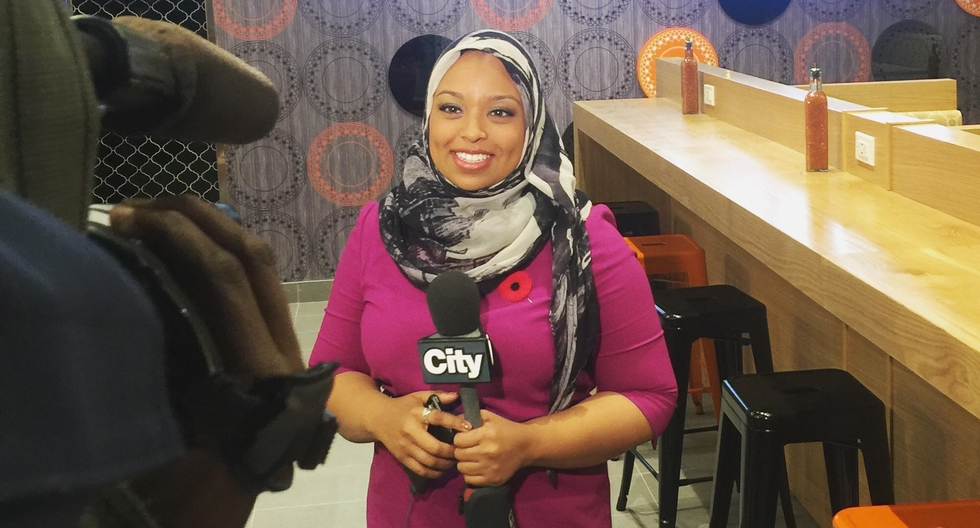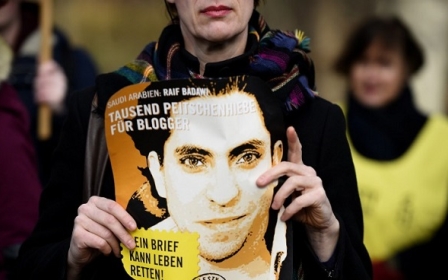Toronto reporter becomes Canada’s first hijab-wearing news anchor

TORONTO, Canada – Ginella Massa was not always sure she wanted to be in front of a camera.
“I had never seen anyone who looked like me on TV, so that sometimes makes you feel like it’s not possible. I had said some time ago, ‘Maybe I’ll go into radio because then it doesn’t matter what I look like,’” the 29-year-old said with a laugh.
But bolstered by her mother’s support, Massa went for it, becoming the first Muslim woman who wears a headscarf to report on camera for a television news programme in Kitchener, Ontario, in 2015.
Last week, she added another important first to her resume: the first woman in a hijab to anchor a Canadian television newscast.
“As much as I knew that it was a milestone, I almost wasn’t prepared for the overwhelming response,” Massa told Middle East Eye in a telephone interview on Tuesday.
She filled in as the anchor of the 11pm newscast on City News, a local television news channel serving Toronto, Canada’s largest city, and the Greater Toronto Area, on 17 November.
After posting a photo of herself on Twitter with the caption, “That's a wrap! Tonight wasn’t just important for me. I don’t think a woman in hijab has ever anchored a newscast in Canada,” the reaction was almost immediate.
And it was overwhelmingly positive, Massa said, “from Muslims who feel like this tells them that they belong in this society when they see someone that looks like me reading their nightly news [and] from non-Muslims who say, it’s about time that our newscasts look like our community”.
Media diversity lacking in Canada
Toronto is one of the most diverse cities in the world. About 1.3 million people, or 49 percent of the city’s total population, identified as a visible minority in 2011, according to the last nationwide census.
Canada prides itself on being a multicultural country. About 6.3 million people in Canada (19.1 percent of the population) identified as being members of a visible minority in 2011.
But that diversity is not reflected in Canada’s news media, or television and film industries – and it has not been for a long time.
In 1994, John Miller, professor emeritus at Ryerson University’s School of Journalism, conducted a survey of racial diversity at 41 newspapers, and found that only 2.6 percent of newsroom staff (67 of 2,620 staff members) identified as minorities.
A decade later, Miller surveyed 34 daily newspapers across Canada, and found that “that racial minorities are more than five times under-represented in daily newsrooms,” while “the commitment of editors to change their hiring patterns” actually declined between 1994 and 2004.
“A majority of managing editors agreed with the statement that ‘minorities just don’t apply here.’ Yet only one mentioned taking any steps to ensure that it was attracting minority candidates, such as recruiting at journalism schools or ethnic publications,” the 2004 report found.
In a blog post from last June, Miller explained that while media organisations in the US have kept track of diversity for more than 30 years, Canada does not. Reports on making Canadian broadcasting more diverse, meanwhile, have been conducted, but go largely unimplemented.
“If newsrooms cannot stay in touch with the issues, the concerns, hopes and dreams of an increasingly diverse audience, those news organisations will lose their relevance and be replaced,” Miller wrote.
“That's not all. By denying media access to ethnic minorities, the public gets a wrong perception of reality and the place ethnic minorities have in society. And that's a recipe for social conflict - the kind of blind fear of ‘the other’ that Donald Trump is stoking in the US presidential election campaign.”
Efforts fall short
In the last year, several Canadian media organisations have sought to tackle diversity, from Colour Code, a podcast on race produced by journalists at The Globe and Mail, to columnists and reporters writing about racial and gender representation more frequently.
But despite having these conversations, Canadian media outlets largely remain under-represented of the larger communities they cover.
Last year, Davide Mastracci described “the unbearable whiteness of Canadian columnists” in an article for the Ryerson Review of Journalism. Of 11 columnists at the Ottawa Citizen, all but one were white, a reality that Mastracci said reflects a wider trend in Canadian newspapers.
“Canadian columnists are predominately white, and this undermines the relevance of the conversation they help shape on a daily basis,” Mastracci wrote.
Most Canadian columnists are also disproportionately male and middle-aged, according to a 2014 survey of Canada’s English-language columnists conducted by J-Source, the Canadian journalism project. It found that of 73 national columnists surveyed, only 27 percent were female and 66 percent had a median age of 58.5 years.
Canadaland, a weekly podcast on media criticism and reporting, recently attempted to get 18 of Canada’s largest daily newspapers to answer a survey on diversity in their newsrooms. Only three newspapers responded.
Meanwhile, the nation’s public broadcaster, the Canadian Broadcasting Corporation (CBC), employs a staff that is about 90 percent white, despite a mandate to reflect the multicultural diversity of Canada’s population.
‘A voice of the people’
For Massa, the importance of media reflecting the communities they are reporting from – from racial and gender diversity, to age, sexual orientation and physical ability – cannot be overstated.
“If we want to truly be a voice for the people in our society, if we want to tap into the stories of the people who live among us, then we need to see diversity in our newsrooms,” she said.
'If we want to truly be a voice for the people in our society, if we want to tap into the stories of the people who live among us, then we need to see diversity in our newsrooms' - Ginella Massa
She said the first step in making newsrooms more diverse is simply creating opportunities for people who might not otherwise have easy access to the industry.
Her work may also help open the door for others in the future, she said. “For young Muslims, it’s really important for them to see themselves not just in television, but also in positions of power, because it tells them that those are the things they can do and achieve.”
“I’m trying to be the best journalist I can be,” Massa added, “and I just happen to wear a scarf while I’m doing it.”
Middle East Eye propose une couverture et une analyse indépendantes et incomparables du Moyen-Orient, de l’Afrique du Nord et d’autres régions du monde. Pour en savoir plus sur la reprise de ce contenu et les frais qui s’appliquent, veuillez remplir ce formulaire [en anglais]. Pour en savoir plus sur MEE, cliquez ici [en anglais].





